Christmas (Pasko): A National Fiesta
The Philippine is known as the “Land of Fiestas” and at Christmas time, this is especially true.
Filipinos are proud to proclaim their Christmas Celebration to be the longest and merriest in the world. It begins formally on December 16 with the attendance at the
first of nine pre-dawn or early morning masses and continues
on nonstop until the first Sunday of January.

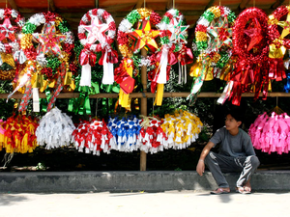
Filipinos enjoys decorating their homes not only with star lanterns
but also with all sorts of Christmas decors.
Christmas in the Philippines is a mixture of Western and Native Filipino traditions.
Santa Clause, the Christmas tree, sending cards, sweets and candies,
family reunions, singing carols, Christmas party, foods, giving gifts, and espacially
the LOVE.



Noche Buena
The Noche Buena is very like in open celebrations. Family, friends, relatives or even unfamiliar people wishes “Maligayang Pasko” or Merry Christmas in each of everyone.
Food is in abundance, often served in buffet style. Among typical foods prepared in the Philippines during Christmas are: Lechon, barbecue, rice, adobo, pancit, leche flan, mango float, fruit salad, spaghetti, cakes, wines, fruits and the Ham.
Every family eats together every 12:00 in the midnight with fun. With that, the spirit of love and sharing raise. Philippine food are all gathered and prepared and will surely be the number one spot in the Christmas.
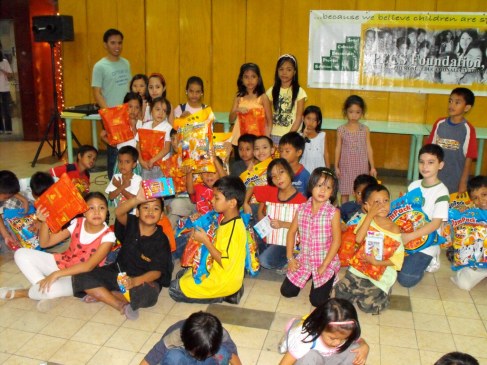
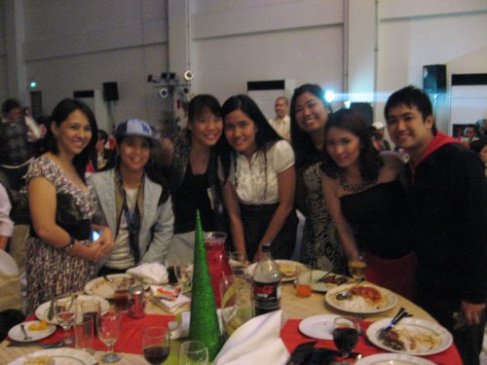
Christmas parties – its more fun in the Philippines.
many offices and all Shcools organize Christmas parties. These are usually held during the second week of December, or right before schools and universities go on holiday. Common activities include Monito/Monita(Kris Kringle), musical or theatrical performances and parlor games. Food is provided either through potluck, or via a pool of contributions to buy food. Some have fireworks displays.
Most of the Filipinos are excited for celebrating Christmas party in different venues and motifs.
That is why Every December, Filipinos were all prepared for it. Christmas Parties is one of the
Filipino culture in celebrating for the Birth of Christ.


Traditional Filipino way of Celebrating the Advent Season – Simbang Gabi (Misa de Gallo)
In some parishes, the Simbang Gabi begins as early as three o’clock in the morning while anticipated Masses begin a day before at eight in the evening. Attendance at the nine Masses is meant to show the believer’s devotion to God as well as to heighten anticipation for the Nativity of Jesus. A popular belief is that upon the devotee’s completion of the nine Masses, God will grant any special wish he makes.
Traditionally, Christmas Day is ushered in by a novena of dawn Masses known as the Misa de Gallo (“Rooster’s Mass”) in Spanish and in Filipino as Simbang Gabi (literally, “Night Mass”). This series of Masses lasts from December 16 to 24, and is a very important tradition. The Simbang Gabi is practised mainly by Catholic and Aglipayan faithful, though some Evangelical Christians and other independent Protestant Churches have adapted this practise by holding similar early morning services.
After hearing Mass, Catholic families eat traditional Filipino holiday fare sold outside the church, either within the church precincts or during breakfast at home. Vendors offer many native delicacies, including bibingka (rice flour and egg-based cake, cooked using coal burners above and under); putò bumbóng (a purple, sticky rice delicacy steamed in bamboo tubes, buttered then sprinkled with brown sugar and shredded dried coconut meat). Drinks include coffee,salabát (a ginger tisane) and tsokoláte (thick Spanish-style hot chocolate).

PANUNULUYAN
Christmas Day in The Philippines is primarily a family affair. The Misa de Aguinaldo is celebrated on December 25 and is usually attended by the whole family. It is the main means of celebrating Jesus Christ’s birth for Catholics and Aglipayans.
The Misa de Aguinaldo is often celebrated between 10 pm and midnight, a schedule preferred by many Filipinos who stay up late on Christmas Eve for the night-long celebration of the Noche Buena.
Preferably in the morning, Filipinos typically visit members of the extended family, especially to pay respects to their elders. This custom of giving respect has been an age-old tradition in the Philippines called “Pagmamáno“, which is done by bringing the elder’s hand to one’s forehead, while saying the phrase Máno Pô (lit. “Hand, please”). The elder then blesses the person who has given their respect, and in return gives “Aguinaldo“, or money in the form of crisp, fresh-from-the-bank bills is given after the Pagmamano, mostly to younger children. Godparents are especially socially obligated to give presents or Aguinaldo to their godchildren.
A Christmas Lunch usually follows after the “Pagmamano“. The menu is heavily dependent upon the finances of the family, with richer families preparing grand feasts, while poorer families choose to cook simple yet special dishes. Some families choose to open presents on this day after the lunch.


New Year’s Eve in the Philippines
On December 31, New Year’s Eve (“Bisperas ng Bagong Taon”), Filipino families gather for the Media Noche or midnight meal – a feast that is also supposed to symbolize their hopes for a prosperous New Year. In spite of the yearly ban on firecrackers, many Filipinos in the Philippines still see these as the traditional means to greet the New Year. The loud noises and sounds of merrymaking are not only meant to celebrate the coming of the New Year but are also cast out malevolent spirits. Safer methods of merrymaking include banging on pots and pans and blowing on car horns. Folk beliefs also include encouraging children to jump at the stroke of midnight so that they would grow up tall, displaying circular fruit and wearing clothes with dots and other circular designs to symbolize money, eating twelve fruits at 12 midnight for good luck in the twelve months of the year, and opening windows and doors during the first day of the New Year to let in the good luck.

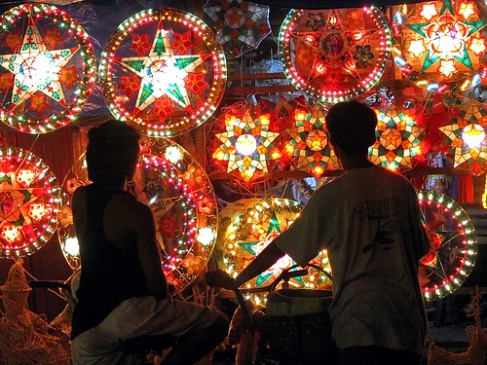
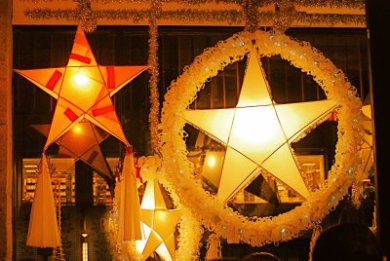
Christmas Lanterns (Parol) – A Filipino Christmas Culture
Every Christmas season, Filipino homes and buildings are adorned with beautiful star-shaped lanterns, called paról (Sp. farol, meaning lantern or lamp-Merriam Webster – English English- Spanish Dictionary). These lanterns represent the Star of Bethlehem that guided the Magi, also known as the Three Kings (Tatlóng Harì in Tagalog). Parols are as beloved and iconic to Filipinos as Christmas trees are to Westerners.
The earliest parols were made from simple materials like bamboo, Japanese rice paper (known as “papél de Hapón“) or crêpe paper, and was lit by a candle or coconut oil-lamp for illumination. The present-day parol has endless possible shapes and forms and is made of a variety of materials.
The Giant Lantern Festival is an annual festival held in December (Saturday before Christmas Eve) in the City of San Fernando in the Philippines. The festival features a competition of giant lanterns. Because of the popularity of the festival, the city has been nicknamed the “Christmas Capital of the Philippines”.


Fun in the Philippines – Christmas Caroling
In the Philippines, children in small groups go from house to house singing Christmas carols, which they called pangangaroling. Makeshift instruments include tambourines made with tansans (aluminum bottle caps) strung on a piece of wire. With the traditional chant of “Namamasko po!“, these carolers wait expectantly for the homeowners to reward them with coins. Afterward, the carolers thank the generous homeowners by singing “Thank you, thank you, ang babait ninyo (you are so kind), thank you!”
More recently, caroling has become a fund-raising activity. Church choirs or youth groups spend weeks rehearsing Christmas carols then draw up a schedule of visits to wealthy patrons in their homes or even corporate offices (often coinciding with the office Christmas party). These are, in effect, mini Christmas concerts, with excellent performances amply rewarded with an envelope of cash or checks. The choirs then use the funds for goodwill projects. Unlike the traditional children’s caroling, the singers do not partake of the earnings, but rather donate their share to the group’s projects.
For the People out there who are planning to Celebrate their Christmas
here in the Philippines, dont forget to try the historical Cultures and Tradition
that will make everyone enjoy. Remember? We, Filipinos welcomes everyone for us to enjoy and celebrate the Birth of Christ. The essence of Christmas here in the Philippines is not just the foods and the fun but the most important is the Spirit of Love, Sharing and Forgiving.
Have a Fun! WEEEEEEE. Celebrate Christmas, Celebrate!
